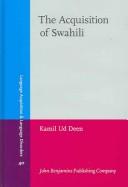| Listing 1 - 5 of 5 |
Sort by
|

ISBN: 1282156268 9786612156267 902729397X 9789027293978 9789027253002 9027253005 9781282156265 6612156260 Year: 2005 Publisher: Amsterdam Philadelphia
Abstract | Keywords | Export | Availability | Bookmark
 Loading...
Loading...Choose an application
- Reference Manager
- EndNote
- RefWorks (Direct export to RefWorks)
This monograph is the first study of the acquisition of Swahili as a first language. It focuses on the acquisition of inflectional affixes, with a particular emphasis on subject agreement and tense. Other inflectional affixes are also investigated, including object agreement and mood. The study surveys the adult dialect in question, Nairobi Swahili, discussing social, phonological, morphological and syntactic properties. Data, analyses and copious examples are presented of the naturalistic speech of four Swahili speaking children. The data are tested against six influential theories of child language, and the results show that processing and metrical theories of telegraphic speech fail to account for the observed patterns, while grammatical theories of child language fair significantly better. The data and analyses presented in this book are indispensable for linguists and psychologists interested in the acquisition of inflectional material and other cross-linguistic properties of child language.
Swahili language --- Children --- Kiswahili language --- Suaheli language --- Bantu languages --- Language development in children --- Interpersonal communication in children --- Language and languages --- Acquisition. --- Dialects --- Verb. --- Affixes. --- Language. --- Vocabulary
Book
ISBN: 9780262357234 0262357232 9780262043588 0262043580 Year: 2020 Publisher: Cambridge, Mass. MIT Press
Abstract | Keywords | Export | Availability | Bookmark
 Loading...
Loading...Choose an application
- Reference Manager
- EndNote
- RefWorks (Direct export to RefWorks)
An introduction to the study of children's language development that provides a uniquely accessible perspective on generative/universal grammar–based approaches. How children acquire language so quickly, easily, and uniformly is one of the great mysteries of the human experience. The theory of Universal Grammar suggests that one reason for the relative ease of early language acquisition is that children are born with a predisposition to create a grammar. This textbook offers an introduction to the study of children's acquisition and development of language from a generative/universal grammar–based theoretical perspective, providing comprehensive coverage of children's acquisition while presenting core concepts crucial to understanding generative linguistics more broadly. After laying the theoretical groundwork, including consideration of alternative frameworks, the book explores the development of the sound system of language—children's perception and production of speech sound; examines how words are learned (lexical semantics) and how words are formed (morphology); investigates sentence structure (syntax), including argument structure, functional structure, and tense; considers such “nontypical” circumstances as acquiring a first language past infancy and early childhood, without the abilities to hear or see, and with certain cognitive disorders; and studies bilingual language acquisition, both simultaneously and in sequence. Each chapter offers a summary section, suggestions for further reading, and exercises designed to test students' understanding of the material and provide opportunities to practice analyzing children's language. Appendixes provide charts of the International Phonetic Alphabet (with links to websites that allow students to listen to the sounds associated with these symbols) and a summary of selected experimental methodologies.
Book
Abstract | Keywords | Export | Availability | Bookmark
 Loading...
Loading...Choose an application
- Reference Manager
- EndNote
- RefWorks (Direct export to RefWorks)
Book

ISSN: 01674331 ISBN: 1283627698 3110238810 9786613940148 9783110238808 3110238802 9783110238815 9781283627696 6613940143 Year: 2012 Volume: 108 Publisher: Berlin Boston
Abstract | Keywords | Export | Availability | Bookmark
 Loading...
Loading...Choose an application
- Reference Manager
- EndNote
- RefWorks (Direct export to RefWorks)
Traditional grammars have stated that clitics are subject or object pronouns whose distributional features make them different from personal pronouns. This book focuses on the acquisition of personal and demonstrative pronouns as well as clitics with respect to determinative phrases in a variety of languages of the Romance family and several indigenous languages, such as Quechua. A particularly original aspect of the present volume is that it not only addresses syntactic issues, but also semantic and pragmatic questions that have been widely neglected in the literature. It also reports on...
Grammar, Comparative and general --- Pronoun. --- Clitics. --- Clitics (Grammar) --- Pronouns --- Accents and accentuation --- Tagmemics --- Function words --- Nominals --- Reflexives --- Romance languages --- African languages --- Language acquisition. --- Pronominals. --- Linguistics --- Philology --- Early Language Acquisition. --- Indigenous Languages. --- Romance Languages.
Book

ISBN: 1788924401 1788924398 9781788924399 9781788924382 178892438X Year: 2019 Publisher: Bristol Blue Ridge Summit
Abstract | Keywords | Export | Availability | Bookmark
 Loading...
Loading...Choose an application
- Reference Manager
- EndNote
- RefWorks (Direct export to RefWorks)
This book brings together 12 previously unpublished language profiles based on the original Language Assessment, Remediation and Screening Procedure (LARSP). The languages featured are: Bangla, Croatian, Colombian Spanish, Inuktitut, Norwegian, Portuguese, Russian, Slovak, Slovenian, Swahili, Tamil and Turkish. Some of these languages are included as they are likely to be encountered as home languages of clients by speech-language therapists and pathologists working in the UK, the US, Australia and elsewhere. Others are included because they are languages found where speech-language pathology services are provided, but where no grammatical profile already exists. The collection will be an invaluable resource book for speech-language pathologists who wish to analyse and assess the grammatical abilities of their clients who speak one of these languages. This new collection complements previous books in this series on the same theme and together they cover 34 languages of the world.
Language disorders in children --- Grammar, Comparative and general. --- Comparative grammar --- Grammar --- Grammar, Philosophical --- Grammar, Universal --- Language and languages --- Philosophical grammar --- Linguistics --- Philology --- Diagnosis. --- Grammar, Comparative --- LARSP. --- grammatical assessment. --- language disorders. --- language profiling. --- speech language pathology. --- speech therapy.
| Listing 1 - 5 of 5 |
Sort by
|

 Search
Search Feedback
Feedback About UniCat
About UniCat  Help
Help News
News